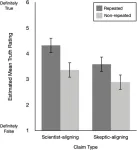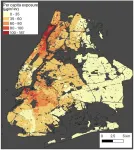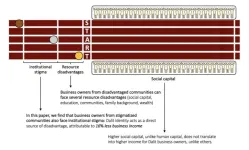(Press-News.org)
Long-term exposure to contaminants such as arsenic and nitrate in water is linked to an increased risk of various diseases, including cancers, cardiovascular diseases, developmental disorders and birth defects in infants. In the United States, there is a striking disparity in exposure to contaminants in tap water provided by community water systems (CWSs), with historically marginalized communities at greater risks compared to other populations. Often, CWSs that distribute water with higher contamination levels exist in areas that lack adequate public infrastructure or sociopolitical and financial resources.
In a recent study published in the American Journal of Public Health, Ms. Sandy Sum, a PhD candidate at the Bren School of Environmental Science & Management, UC Santa Barbara, investigated the drinking water quality in California’s CWSs serving majority Latino/a communities. Ms. Sum analyzed trends in nitrate and arsenic concentrations in drinking water sourced from both surface and groundwater, using a varied set of data, including water sampling data, historical drought records, sociodemographic characteristics of the populations, measures of agricultural intensity and CWS characteristics from the period 2007–2020. Her study found that these systems consistently exhibit higher and more variable levels of nitrate and arsenic compared to those serving non-majority Latino/a populations. She also found that instances of drought increased the contamination in CWSs serving these communities. “Drought increased nitrate concentrations in majority Latino/a communities, with the effect doubling for CWSs with more than 75% Latino/a populations served. Arsenic concentrations in surface sources also increased during drought for all groups,” explains Ms. Sum.
Nitrate concentrations in groundwater-sourced drinking water increased from a baseline of 2.5 mg/L in 1998 to a peak of 3.1 mg/L in 2018 for majority Latino/a CWSs. In contrast, nitrate levels in non-majority Latino/a CWSs decreased from 2.1 mg/L to 1.8 mg/L over the same period. This widening disparity in nitrate exposure is particularly pronounced in surface-sourced water, where majority Latino/a CWSs show a mean nitrate concentration of 2.2 mg/L, significantly higher than the 1.2 mg/L observed in non-majority Latino/a CWSs as of 2020.
Drought conditions exacerbated these disparities, with a notable impact on surface-sourced drinking water. For majority Latino/a CWSs, drought conditions lead to an increase in nitrate levels, with a 2-unit increase in the normalized drought index resulting in a 0.04 mg/L rise in nitrate concentrations for CWSs serving more than 25% Latino/a populations. The increase is more pronounced in systems serving over 75% Latino/a populations, with a 0.16 mg/L rise. This effect is particularly evident in very small (<500 connections) and privately operated CWSs, where nitrate concentrations are more susceptible to drought conditions. Surface-sourced water shows a drought-related increase in nitrate levels of 0.17 mg/L, more than double the increase observed in groundwater sources (0.07 mg/L).
“[The findings] are concerning when we consider that although more CWSs, about 77%, are supplied by groundwater, more people, almost 80%, are served by CWSs that use surface water as their primary source,” Ms. Sum notes. “Impending droughts driven by climate change may further increase drinking water disparities and arsenic threats. This underscores the critical need to address existing inequities in climate resilience planning and grant making,” she explains further.
Additionally, arsenic concentrations in drinking water also exhibited variability under drought conditions. Drought increases overall arsenic concentrations in surface-sourced drinking water for both majority and non-majority Latino/a CWSs. However, for majority Latino/a communities, drought leads to a statistically insignificant decrease in arsenic levels in groundwater-sourced drinking water. This trend contrasts with recent findings in the San Joaquin Valley, where drought-related intensified agricultural groundwater pumping has significantly increased nitrate prevalence by 3 to 5 times in public supply wells, highlighting a broader regional issue.
The study underscores the need for enhanced drought resilience measures, particularly for very small and privately operated CWSs serving Latino/a communities. “[The differential] effects I found suggest that CWSs serving Latino/a communities are not mitigating elevated nitrate concentrations during drought conditions, which exacerbates existing disparities. This may reflect a lack of treatment infrastructure, resource constraints or other operational or technical differences,” says Ms. Sum. “Although I focused on only arsenic and nitrate concentrations, these vulnerable CWSs may also be at increased risk for contamination from other sources like pesticides, waste disposal sites and manufacturing plants, under stressors such as drought, floods and other natural events,” Ms. Sum concludes on a cautionary note.
Future research should explore how drought impacts arsenic and nitrate levels to help understand the public health implications and guide policy initiatives for ensuring safe and equitable drinking water access.
END
Living less than about one-third of a mile from pesticide use prior to conception and during early pregnancy could increase the risk of stillbirths, according to new research led by researchers at the Mel and Enid Zuckerman College of Public Health and Southwest Environmental Health Sciences Center.
Researchers found that during a 90-day pre-conception window and the first trimester of pregnancy, select pesticides, including organophosphates as a class, were associated with stillbirth.
The paper, “Pre-Conception ...
Affective sensitivity to air pollution (ASAP) describes the extent to which affect, or mood, fluctuates in accordance with daily changes in air pollution, which can vary between individuals, according to a study published August 7, 2024 in the open-access journal PLOS ONE by Michelle Ng from Stanford University, USA, and colleagues.
Individuals’ sensitivity to climate hazards is a central component of their vulnerability to climate change. Building on known associations between air pollution exposure and ...
Climate science supporters rated climate-skeptical statements as “truer” after just a single repetition, according to a study published August 7, 2024 in the open-access journal PLOS ONE led by Mary Jiang from The Australian National University, Australia, and coauthored by Norbert Schwarz from the University of Southern California, USA, and colleagues. The results held true even for the strongest climate science supporters surveyed.
Amidst the influx of content that a person consumes each day, the principle of motivated ...
New York City subway commuters who are economically disadvantaged or belong to racial minority groups have the highest exposure to fine particulate matter during their commutes, according to a new study published August 7, 2024 in the open-access journal PLOS ONE by Shams Azad of New York University, USA.
Fine particulate matter (PM2.5) is a type of air pollution that, due to its small size, when inhaled by a person can enter the bloodstream. PM2.5 is known to cause short- and long-term health complications. For the last few decades, cities have promoted public transportation to reduce traffic congestion and improve ambient outdoor air quality. Subway systems reduce pollution by decreasing ...
Women who spend a lot of time on TikTok — especially those seeing a lot of pro-anorexia content — feel worse about their appearance, a new study shows. The results suggest that high TikTok exposure could harm mental health, reducing body image satisfaction and increasing the risk for disordered eating behavior. Madison Blackburn and Rachel Hogg from Charles Sturt University in Australia present these findings in the open-access journal PLOS ONE on August 7, 2024.
Since its launch, the short-form video app TikTok has had more than 2 billion downloads. The app’s algorithm curates content on a “For ...
In a new survey study, Dutch employees who worked from home tended to report higher levels of productivity and less burnout if they were more satisfied with their home office setup. The study also linked more air ventilation in the home office to higher self-reported productivity. Martijn Stroom and colleagues at Maastricht University in the Netherlands report these findings in the open-access journal PLOS ONE on August 7, 2024.
In recent years, thanks in large part to the COVID-19 pandemic and technological advancements, ...
Trained dogs can sniff out CWD, a disease of major concern, in the droppings of farmed and wild deer, offering potential for non-invasive surveillance
###
Article URL: https://journals.plos.org/plosone/article?id=10.1371/journal.pone.0303225
Article Title: Biodetection of an odor signature in white-tailed deer associated with infection by chronic wasting disease prions
Author Countries: USA
Funding: TWRA AP-14839 Animal and Plant Health Inspection Service and WILDLIFE RESOURCES AGENCY, TENNESSEE https://www.aphis.usda.gov/aphis/ourfocus/business-services/financial-management-division/financial_services_branch/agreements_service_center/terms-conditions-for-aphis-awards ...
Ice cream made from mare's milk blended with cow's cream not only tastes good, but may have beneficial probiotic qualities
###
Article URL: https://journals.plos.org/plosone/article?id=10.1371/journal.pone.0304692
Article Title: The use of mare’s milk for yogurt ice cream and synbiotic ice cream production
Author Countries: Poland
Funding: The author(s) received no specific funding for this work. END ...
Indian business owners from the stigmatized Dalit group experience a business income gap of around 16% compared to others
###
Article URL: https://journals.plos.org/plosone/article?id=10.1371/journal.pone.0307660
Article Title: It’s not who you know, but who you are: Explaining income gaps of stigmatized-caste business owners in India
Author Countries: India, UK, Australia
Funding: The author(s) received no specific funding for this work. END ...
An archaeological strategy adapted for space used daily photos to reveal how astronauts actually use areas aboard the International Space Station – and how this differs from intended uses. Justin Walsh of Chapman University, California, and colleagues present these findings in the open-access journal PLOS ONE on August 7, 2024.
More than 270 people from 23 countries have visited the International Space Station (ISS) over more than two decades. Crew member interviews can reveal how people adapt to a novel environment—one featuring isolation, confinement, and microgravity—that is far removed ...











